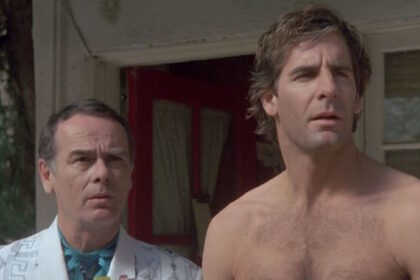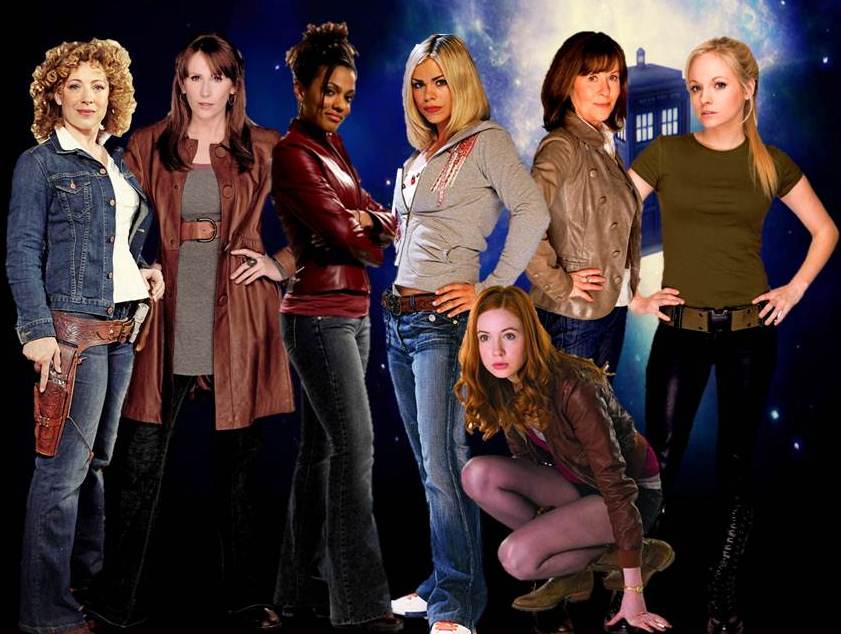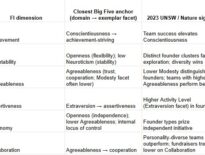
As someone who grew up on MacGyver inventing solutions from chewing gum wrappers and paperclips, I’m ashamed I never put thought to my second favorite hero of the week, Sam Beckett. I’m a huge fan of what pop culture teaches and inspires in future entrepreneurs because like startups, innovation is never the clean, linear story Silicon Valley marketing departments like to pitch; it’s a new challenge every week, requiring a team of people capable of overcoming. It’s messy, improvisational, and more often than not, it looks like time travel; being hurled into a situation you don’t fully understand, forced to solve problems with incomplete information, and relying on others to stumble toward success. It’s a Quantum Leap. These are the true innovation lessons.
So, you, founders, don’t lose your shirt like Scott Bakula looking confused as he often did, let me explain.
When NBC first aired the original Quantum Leap in 1989, it was disguised as science fiction: Dr. Sam Beckett (Scott Bakula), a physicist, creates the “Quantum Leap Accelerator” and disappears into history, Inhabiting the lives of strangers. Every episode, Sam wakes up in someone else’s life, a little lost, sometimes terrified, but always with the same mission: “to put right what once went wrong,” you can see how the story inspires entrepreneurship. The show ran until 1993 and became a cult classic because it was more than sci-fi; it was a morality play about courage, problem-solving, and human connection.
Fast forward to 2022, NBC revived the series with Dr. Ben Song as the new leaper and I decided to tune in this week, drawing my attention back to its impact. This time, the reboot leaned into today’s cultural obsession with data, networks, and systems. Where the original emphasized heart and instinct, the new series doubles down on information asymmetry: Ben has to rely on a modernized Ziggy, an upgraded team, and an entire operation back at headquarters trying to piece together the past while nudging him toward the right outcome (I can’t count how many times Dr. Ben Song, in the past, exclaims “if I only had the internet!”). If the first Quantum Leap mirrored the founder-as-hero myth, the new one mirrors how startups actually work now: the founder may be the one taking the leap, but behind them is a multidisciplinary team feeding data, building infrastructure, and recalculating odds in real time. It’s not just one man stumbling through history anymore, it’s a startup accelerator in the cloud.
And here’s why entrepreneurs should care: Sam (or Ben) is the CEO. He’s the founder, passionate but also a little naïve while being brave enough to leap into a broken system and believe it can be fixed. He’s improvising, he’s risking, he’s embodying vision in the face of absolute uncertainty.
Al Calavicci, a cigar-chomping hologram who appears to Sam each episode to fill him in on what’s known from history (stay with me, Sam is in the past so Al is from the present, or his future), is the CTO. He doesn’t fix the problems himself, but he has the data and the framework to make sense of them and direct a solution. Al interprets Ziggy’s output, translates it into actionable insights, and provides the founder with just enough context to keep moving. If you’ve ever had a CTO tell you, “The tech doesn’t work like that, but here’s a workaround,” you’ve lived this dynamic.
And Ziggy? Well, if you’re read much of what I write, or bothered to pay attention to the research into what makes startups work, you know where this is going: Ziggy is the CMO. Not because Ziggy has personality, but because Ziggy knows the market. Ziggy has all of the data available from newspapers, archives, and records. Ziggy runs the odds, calculates customer reactions, models outcomes. In the original series, Ziggy was often wrong or incomplete; reminding us that market data is never perfect but that without it, you’re lost. In the recent reboot, Ziggy is upgraded, more networked, and more probabilistic, just like modern marketing. Ignore Ziggy, and both Sam and Ben are making it up as they go – too much like many of you. Still, trust Ziggy blindly, and you’ll optimize yourself into irrelevance; without Al working in the middle to provide context, consider solutions, and adjust based on what the CEO is capable of pulling off, everything is lost in translation. The balance is in the interplay.
That’s the lesson of Quantum Leap: innovation happens at the intersection of vision (CEO), technical problem-solving (CTO), and market reality (CMO). Every leap is a startup case study: incomplete information, limited time, unpredictable variables, but always the same mandate: fix what’s broken and make it stick.
This three-party structure is not just television convention, the lesson goes much further back in time, with The Butcher, The Baker, and the Candlestick Maker even guiding us to what keeps things afloat. It’s a reflection of how human systems actually work.
Quantum Leap not familiar? Consider Doctor Who. At first glance, it looks wildly different. A near-immortal alien in a time machine, traveling with human companions through alien worlds. But structurally, it’s the same. The Doctor is the Quantum Leap’s hologram: eccentric, brilliant, technical. The Companion (a friend found on earth who travels with Doctor Who) is the leaper; human, emotionally grounded, stumbling through unfamiliar terrain. And the TARDIS is Ziggy, a machine humming with knowledge, probability, and directional guidance, dropping them into the places they’re needed most. Doctor, companion, machine. Same triad, same dynamic.
This triad has repeated itself across decades of storytelling because it reflects something fundamental about innovation. One person can’t do it alone. You need the visionary who dares to leap, the technologist who grounds that vision in reality, and the market voice that keeps both from solving irrelevant problems. Without all three, you’re not innovating, you’re just inventing. And invention without adoption is the graveyard where good ideas go to die.
Should we do it again? Layer on Star Trek, which has been orbiting our culture since 1966. Gene Roddenberry didn’t create a space opera; he created a team case study. At the heart of the Enterprise are three characters: Captain James T. Kirk, Mr. Spock, and Dr. Leonard “Bones” McCoy. Kirk is the CEO – visionary, risk-taking, decisive to the point of recklessness. Spock is the CTO – logical, analytical, a walking algorithm who translates chaos into solvable equations. Bones is the CMO—the voice of humanity, the market, the one who constantly reminds the others that real people live with the consequences of their decisions. “Dammit, Jim, I’m a doctor, not an engineer,” is another way of saying, “Stop obsessing over the tech and remember the customer.”
Innovation Lessons
The reboot of Quantum Leap drives this home with more force. In today’s world, founders aren’t just leaping into the unknown; they’re leaping with an entire infrastructure of data, AI, and teams behind them. It’s sending a message I’m increasingly driving, that you must have that infrastructure in place, whether it’s Google Analytics, ChatGPT, Founder Institute’s network and program, or Founders’ Best Friend’s frameworks, the founder is still the point of risk, but the system is distributed. Innovation today isn’t a lonely accelerator experiment; it’s a collective leap, with headquarters calculating, teams iterating, and market signals constantly reshaping the odds.
What should entrepreneurs take away from all this TV philosophy? That the garage myth is a lie – or rather, getting yourself in an innovation space is irrelevant. That every great innovation is a three-body problem (which means, I suppose, now I have to dig into that series). And that if your startup team doesn’t have its Sam, its Al, and its Ziggy, if it doesn’t have its Kirk, Spock, and Bones, or its Doctor, companion, and TARDIS, you’re not set up to innovate. You’re set up to stumble blindly and pray.
As for MacGyver, well, I suppose he’s our unicorn, and let’s be honest, most of us aren’t MacGyver.





This makes me think about our own founder community — the most successful stories always have that balance between vision, execution, and market pull!
lume and what’s funny is how often communities, accelerators, even investors say they want that balance, but then reward the loud visionary without checking if there’s an “Al” or a “Ziggy” anywhere nearby. The stories we celebrate make it seem like vision alone is enough, when in reality it only works because execution and market insight were in the room.
Curious, in your founder community, do you see more gaps on the execution side, or on the market side?
Innovation without market grounding often turns into expensive tinkering, Paul.
Mikaela Berman and THAT is why so many brilliant ideas never leave the lab or the garage. Vision and execution can build anything, but without market grounding it’s just a science fair project.
The challenge is that most founders don’t know they’re “tinkering” until it’s too late; they think traction will catch up.
Do you think investors are doing enough to spot when a team is innovating versus just tinkering?
Quantum Leap, was one of my families favorite shows I would watch as a kid. very interesting, and intriguing, I am happy about this correlation, it makes me think, about business and the order of the universe, Scott Bakula seems to always have a solution.
Cynthia Same here. Was one of those shows my family always stopped to watch together. Funny how it worked on two levels: as kids we saw the adventure, as adults we realize it was teaching us about responsibility, problem-solving, and the belief that things can be made right. Scott Bakula wasn’t just leaping through time, he was showing us how vision, teamwork, and hope hold the universe (or a business) together.
Love the original take, Paul (even though I’m more Star Wars…which would mean Leia as CMO?). The Bones = CMO analogy works…not running the bridge or the engines, just the loud voice reminding everyone that real people live with the consequences. And yeah, not every day is MacGyver, some days it’s definitely MacGruber.
Jeff, Ha! Leia as CMO actually works perfectly: strategist, communicator, and the one reminding the rebels what they’re fighting for. And yes, Bones was never running the bridge or the engines, but he was the conscience of the Enterprise, pulling vision and execution back to the human stakes. I probably should have gone for Kirk, Spock, and Scotty.
Every founder knows that feeling when brilliance slips into barely-held-together chaos. The trick is knowing when you’re improvising smartly and when you’re just duct-taping the rocket.
Hey, did you get my invite? See you Friday?
Mikaela Berman Yes. But is that always a bad thing? How many “tinkerings” did the likes of da Vinci, Edison, Tesla, Monet, etc. churn out? Yes, once you decide to go to market, then the tinkering should stop, or be heavily mitigated.
But “tinkering” can and does lead to happy accidents (e.g., Post-It notes, Viagra, etc.) so let’s not totally dismiss tinkering. It’s part of the innovation process.
Mark Simchock maybe it’s?
Trying > Testing > Inventing > Marketing > Innovation
Sort of analogous to:
Practice > Experience > Creating > Founding
Paul O’Brien Absolute truth. Doctor Who is a masterclass in this. Its “regeneration” is the ultimate innovation framework: the visionary (new Doctor’s personality), the technologist (showrunner’s new rules), and the market (audience reaction shaping the next iteration). It didn’t just invent a character; it built a resilient system that adapts to survive, precisely because it balances those three forces. The garage myth never lasts 60 years.
Leonardo Jun Natsumeda excellent point.
Paul O’Brien Great point! We tend to see execution gaps more often, but missing market insight can be just as challenging. Both are critical in different ways.